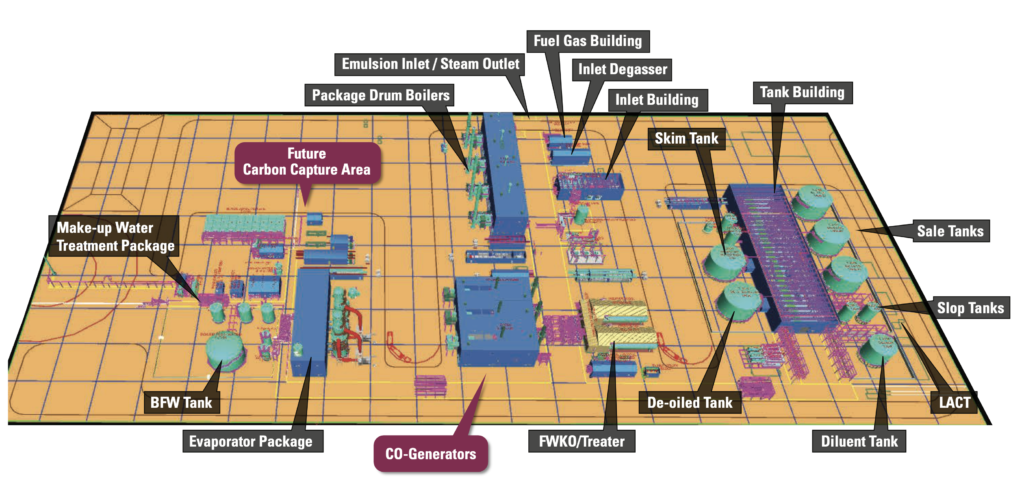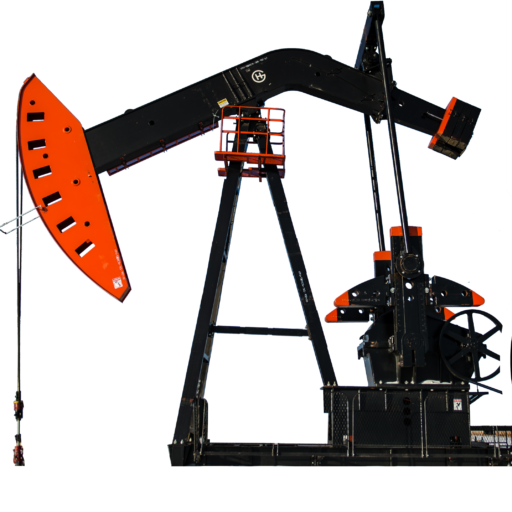Deborah Jaremko is Director, Content and Website Management, for the Canadian Energy Centre. She previously worked with JWN Energy. The Canadian Energy Centre’s mandate is to promote Canada as the supplier of choice for the world’s growing demand for responsibly produced energy. It is an independent provincial corporation that is primarily supported by the Government of Alberta’s industry-funded Technology, Innovation and Emissions Reduction (TIER) fund.
‘I think the value of this resource base is materially underestimated’

Schematic of the Blackrod Phase 1 central processing facility. Image courtesy International Petroleum Corporation
For the first time in five years, a new major oil sands project has been given the green light to go ahead.
Vancouver, B.C.-based International Petroleum Corporation (IPC) is going ahead with the C$1.1 billion development, called Blackrod, because of the vast resources and energy security it provides, says CEO Mike Nicholson.
“Our undeveloped resources sit in Canada, which is the largest resource holder behind Saudi Arabia and behind Venezuela, and we’re certainly not welcome in those locations,” Nicholson said during a Feb. 7 investor presentation.
“It’s a very stable fiscal regime [and] a very stable political regime for oil and gas investment, and I think the value of this resource base is materially underestimated.”
IPC has accelerated plans for the first phase of the Blackrod project, Nicholson said.
Over the last year the company has increased planned production capacity by 10,000 barrels per day. The project will now be built to produce 30,000 barrels per day, with first oil expected in late 2026.
Blackrod has regulatory approval to produce 80,000 barrels per day.
- 0100 Turnbull Project Manager0100 Turnbull Project Manager
- 0099 Mryglod Steel 1080p0099 Mryglod Steel 1080p
- 0097 Eagle Sky Ventures LTD0097 Eagle Sky Ventures LTD
- 0095 Fast Trucking nearly 70 years good at it0095 Fast Trucking nearly 70 years good at it
- 0053 Kingston Midstream Westspur Alameda Click Before You Dig0053 Kingston Midstream Westspur Alameda Click Before You Dig
- 0092 Turnbull projects big and small0092 Turnbull projects big and small
- 0046 City of Estevan This is Estevan Teaser0046 City of Estevan This is Estevan Teaser
- 0087 Lori Carr Coal Expansion0087 Lori Carr Coal Expansion
- 0077 Caprice Resources Stand Up For Free Speech0077 Caprice Resources Stand Up For Free Speech
- 0076 Latus only0076 Latus only
- 0061 SIMSA 2024 For Sask Buy Sask0061 SIMSA 2024 For Sask Buy Sask
- 0055 Smart Power Be Smart with your Power office0055 Smart Power Be Smart with your Power office
- 0051 JML Hiring Pumpjack assembly0051 JML Hiring Pumpjack assembly
- 0049 Scotsburn Dental soft guitar0049 Scotsburn Dental soft guitar
- 0041 DEEP Since 2018 now we are going to build0041 DEEP Since 2018 now we are going to build
- 0032 IWS Summer hiring rock trailer music
- 0022 Grimes winter hiring
- 0021 OSY Rentals S8 Promo
- 0018 IWS Hiring Royal Summer
- 0013 Panther Drilling PO ad 03 top drive rigs
- 0006 JK Junior
- 0002 gilliss casing services0002 gilliss casing services
- 9002 Pipeline Online 30 sec EBEX9002 Pipeline Online 30 sec EBEX
- 9001
While IPC may be unique in going ahead with a brand new, so-called “greenfield” oil sands project, the industry’s largest operators are also building for the future.
In Cenovus Energy’s case, long into the future. The company recently filed a regulatory application to extend production at its Christina Lake oil sands project to 2079.
One of the first commercial-scale steam assisted gravity drainage (SAGD) projects, Christina Lake (not to be confused with MEG Energy’s smaller Christina Lake project), is now the industry’s largest “in situ” facility. It produced about 245,000 barrels per day in 2022, or about 16 per cent of the in situ oil sands industry’s total.
Cenovus plans to keep production going for another 50 years by adding well pads in a new area called Kirby West and connecting them to the existing main processing facility.
The extension project is expected to cost about $2.4 billion, and over its decades-long lifespan generate $3.8 billion in royalties and taxes for the governments of Alberta and Canada. First oil is expected in 2031.
As a member of the Pathways Alliance, Cenovus has set the target to reach net zero emissions by 2050, meaning that oil produced beyond that time would incorporate emissions reduction and removal technologies like carbon capture and storage (CCS).
“The oil sands has grown to be a major source of supply globally, and in a system over three million barrels per day, optimizing existing infrastructure can deliver growth, and in some instances with negligible incremental emissions,” says Kevin Birn, who leads S&P Global’s Centre of Emissions Excellence and serves as chief analyst for Canadian oil markets.
Although demand for transportation fuel may eventually weaken, petroleum is also used to make countless products that are expected to rise in demand, from clothing, computers, cell phones, car components and sports equipment to furniture, medical supplies, carpets, toys, and beauty products. Oil – and particularly heavy oil like what is produced in Canada – is also used to make asphalt to make road paving products.
World oil demand is expected to reach a record 101.7 million barrels per day this year, according to the International Energy Agency. Even with increasing adoption of renewable and alternative energy, the IEA projects that global demand will be 102 million barrels per day in 2050.
Eight Capital oil analyst Phil Skolnick says the Kirby West project is “a natural progression” of Cenovus Energy’s Christina Lake project, which started operating in 2002.
“Technology has improved, and they have found ways to be more efficient,” he says.
- 0100 Turnbull Project Manager0100 Turnbull Project Manager
- 0099 Mryglod Steel 1080p0099 Mryglod Steel 1080p
- 0097 Eagle Sky Ventures LTD0097 Eagle Sky Ventures LTD
- 0095 Fast Trucking nearly 70 years good at it0095 Fast Trucking nearly 70 years good at it
- 0053 Kingston Midstream Westspur Alameda Click Before You Dig0053 Kingston Midstream Westspur Alameda Click Before You Dig
- 0092 Turnbull projects big and small0092 Turnbull projects big and small
- 0046 City of Estevan This is Estevan Teaser0046 City of Estevan This is Estevan Teaser
- 0087 Lori Carr Coal Expansion0087 Lori Carr Coal Expansion
- 0077 Caprice Resources Stand Up For Free Speech0077 Caprice Resources Stand Up For Free Speech
- 0076 Latus only0076 Latus only
- 0061 SIMSA 2024 For Sask Buy Sask0061 SIMSA 2024 For Sask Buy Sask
- 0055 Smart Power Be Smart with your Power office0055 Smart Power Be Smart with your Power office
- 0051 JML Hiring Pumpjack assembly0051 JML Hiring Pumpjack assembly
- 0049 Scotsburn Dental soft guitar0049 Scotsburn Dental soft guitar
- 0041 DEEP Since 2018 now we are going to build0041 DEEP Since 2018 now we are going to build
- 0032 IWS Summer hiring rock trailer music
- 0022 Grimes winter hiring
- 0021 OSY Rentals S8 Promo
- 0018 IWS Hiring Royal Summer
- 0013 Panther Drilling PO ad 03 top drive rigs
- 0006 JK Junior
- 0002 gilliss casing services0002 gilliss casing services
- 9002 Pipeline Online 30 sec EBEX9002 Pipeline Online 30 sec EBEX
- 9001
